The 570s decade ran from January 1, 570, to December 31, 579.

Year 579 (DLXXIX) was a common year starting on Sunday of the Julian calendar. The denomination 579 for this year has been used since the early medieval period, when the Anno Domini calendar era became the prevalent method in Europe for naming years.

Year 591 (DXCI) was a common year starting on Monday of the Julian calendar. The denomination 591 for this year has been used since the early medieval period, when the Anno Domini calendar era became the prevalent method in Europe for naming years.

Year 576 (DLXXVI) was a leap year starting on Wednesday of the Julian calendar. The denomination 576 for this year has been used since the early medieval period, when the Anno Domini calendar era became the prevalent method in Europe for naming years.

Daf, also known as dâyere and riq, is a Middle Eastern frame drum musical instrument, used in popular and classical music in South and Central Asia. It is also used in Afghanistan, Azerbaijan, Tajikistan, Iran, Uzbekistan, many regions of Georgia, Pakistan as well as in parts of India and Russian polar regions. It is also popular among Balkans, Bukharan Jews, Caucasians, Kurds, and Macedonians.

Kermanshah Province is one of the 31 provinces of Iran and one of the provinces which border Iraq. The province was known from 1969 to 1986 as Kermanshahan, and from 1986 to 1995 as Bakhtaran. The capital of the province is the city of Kermanshah. According to a 2014 segmentation by the Ministry of Interior, it is the center of Region 4, with the region's central secretariat located in Kermanshah. A majority of people in Kermanshah Province are Shia, and there are Sunni and Yarsani minority groups.

Mazdak was a Zoroastrian mobad (priest), Iranian reformer, prophet and religious reformer who gained influence during the reign of the Sasanian emperor Kavadh I. He claimed to be a prophet of Ahura Mazda and instituted social welfare programs.

Shirin was wife of the Sasanian King of Kings (shahanshah) Khosrow II. In the revolution after the death of Khosrow's father Hormizd IV, the General Bahram Chobin took power over the Persian empire. Shirin fled with Khosrow to Syria, where they lived under the protection of Byzantine emperor Maurice. In 591, Khosrow returned to Persia to take control of the empire and Shirin was made queen. She used her new influence to support the Christian minority in Iran, but the political situation demanded that she do so discreetly. Initially she belonged to the Church of the East, the so-called Nestorians, but later she joined the miaphysite church of Antioch, now known as the Syriac Orthodox Church. After conquering Jerusalem in 614, amidst the Byzantine–Sasanian War of 602–628, the Persians captured the True Cross of Jesus and brought it to their capital Ctesiphon, where Shirin took the cross in her palace.
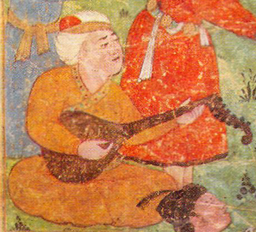
Barbad was a Persian poet-musician, lutenist, music theorist and composer of Sasanian music. He served as chief minstrel-poet under the Shahanshah Khosrow II. A barbat player, he was the most distinguished Persian musician of his time and is regarded among the major figures in the history of Persian music.
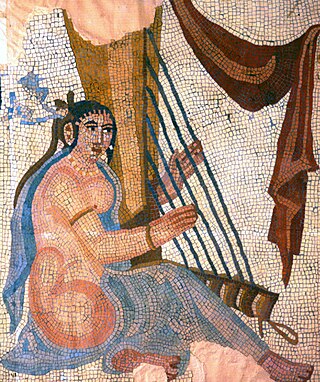
Sasanian music encompasses the music of the Sasanian Empire, which existed from 224 to 651 CE. Many Sasanian Shahanshahs were enthusiastic supporters of music, including the founder of the empire Ardashir I and Bahram V. In particular, Khosrow II was an outstanding patron, his reign being regarded as a golden age of Persian music.

Shabdiz was the legendary black stallion of Khosrau Parvez, one of the most famed Sassanid Persian kings. Shabdiz, meaning "midnight", was reputedly the "world's fastest horse" according to ancient Persian literature. In Nizami's romantic epic Khosrau and Shirin, it is Khosrau's 'beloved' Shabdiz that whisks his future bride, Shirin, to meet him after Shirin has fallen in love with Khosrau's portrait. A musician, Barbad, through a song - potentially risking his life - informed the king of Shabdiz's death.
Iranian philosophy or Persian philosophy can be traced back as far as to Old Iranian philosophical traditions and thoughts which originated in ancient Indo-Iranian roots and were considerably influenced by Zarathustra's teachings. According to the Oxford Dictionary of Philosophy, the chronology of the subject and science of philosophy starts with the Indo-Iranians, dating this event to 1500 BC. The Oxford dictionary also states, "Zarathustra's philosophy entered to influence Western tradition through Judaism, and therefore on Middle Platonism."

The SasanianEmpire or Sassanid Empire, also known as the Second Persian Empire or Neo-Persian Empire, was the last Iranian empire before the early Muslim conquests of the 7th–8th centuries AD. Named after the House of Sasan, it endured for over four centuries, from 224 to 651 AD, making it the second longest-lived Persian imperial dynasty, after the Arsacids. The Sasanian Empire succeeded the Parthian Empire, and re-established the Persians as a major power in late antiquity alongside its neighbouring arch-rival, the Roman Empire. The empire ended with the Arab conquest of Iran.

The siege of Constantinople in 626 by the Sassanid Persians and Avars, aided by large numbers of allied Slavs and Bulgars ended in a strategic victory for the Byzantines. The failure of the siege saved the empire from collapse, and, combined with other victories achieved by Emperor Heraclius the previous year and in 627, enabled Byzantium to regain its territories and end the destructive Roman–Persian Wars by enforcing a treaty with borders status quo c. 590.
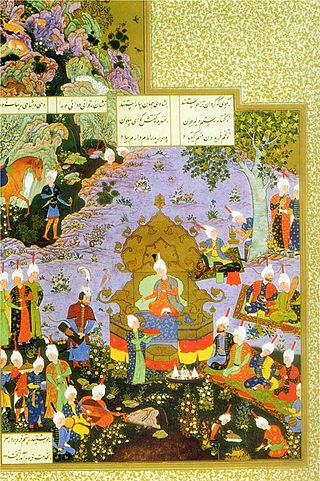
Kay Kawad is a mythological figure of Iranian folklore and oral tradition. The 'Kay' stock epithet identifies Kawad as a Kayanian, a mythological dynasty that in tradition Kay Kawad was also the founder of. In the Shahnameh, the 'Kay' epithet is not always indicative of a king being of Kayanian origin. For instance, Kavad I, who was a Sassanid King, is frequently referred to as 'Kay Qobād' in the Story of Mazdak and Qubad.
Nagisa or Nakisa was a noted harpist and composer of Sasanian music in the royal court Khosrow II.
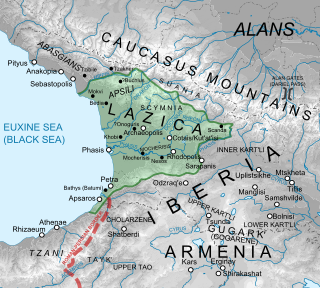
The siege of Phasis took place in 555–556 during the Lazic War between the Byzantine and Sasanian Empires. Expecting an easy victory, the Persians besieged the town of Phasis in Lazica, held by the Byzantines, but were defeated in the ensuing irregular battle. The main source for the siege is the 6th-century historian Agathias.
Zarrin Kafsh also Zarrinkafsh is the name of a Kurdish tribe in Kurdistan Province of Iran which took part in the history of the Iranian Kurdistan Province especially the city of Sanandaj under the rule of the Ardalan princes. The families of Zarrinnaal and Zarrinkafsh belong to this tribe.

Sasanian art, or Sassanid art, was produced under the Sasanian Empire which ruled from the 3rd to 7th centuries AD, before the Muslim conquest of Persia was completed around 651. In 224 AD, the last Parthian king was defeated by Ardashir I. The resulting Sasanian dynasty would last for four hundred years, ruling modern Iran, Iraq, and much territory to the east and north of modern Iran. At times the Levant, much of Anatolia and parts of Egypt and Arabia were under its control. It began a new era in Iran and Mesopotamia, which in many ways was built on Achaemenid traditions, including the art of the period. Nevertheless, there were also other influences on art of the period that came from as far as China and the Mediterranean.
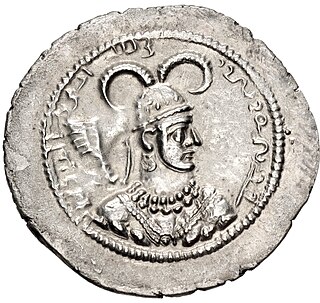
Shapur IV, was king of Sasanian Armenia from 415 to 420, who briefly ruled the Sasanian Empire in 420.
















